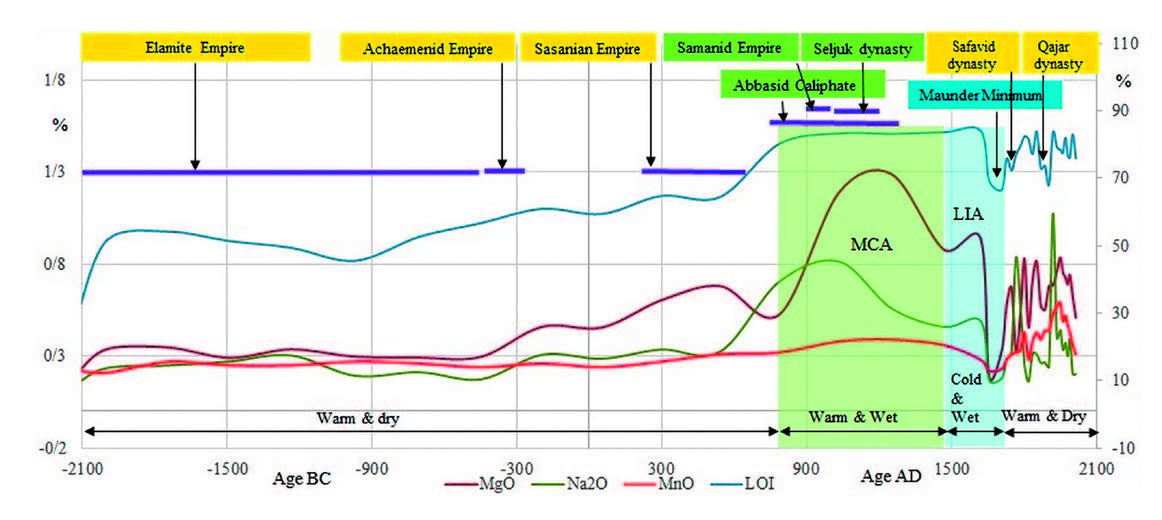Bat guano and historical evidence of climate changes in the west of Iran during the Late Holocene (Meghalayan Stage)
DOI:
https://doi.org/10.3986/ac.v48i2.6787Abstract
An 86 cm thick sequence of bat guano layers in the Kolatarika Cave in Kurdistan province in the west of Iran was analysed. The sequence was radiocarbon dated and covers an age of approximately 4060 years. The results of geochemical data, statistical studies, along with the investigation, analysis and explanation of historical sources indicate the presence of warm and dry climate conditions between ca 2100 BC and 800 CE. These were contemporaneous with the occurrence of periods of drought and famine during the Achaemenid and Sassanid empires, and might have been was one of the causes of their ‘collapse. The existence of humid climate conditions between 800 and 1450 AD was contemporaneous with the period of Medieval Climate Anomaly and the historically documented prosperity of farms and agriculture during the Seljuk dynasties, the Samanids, and the rise of rainfall and river floods during the period of the Abbasid caliphate. The presence of cold and humid climate conditions between ca 1600 and 1750 AD was consistent with the so-called Little Ice Age and the Maunder Minimum. After this period, the climate of this area changed to warm and dry which was contemporaneous with the occurrence of famine and subsequent droughts of the late Safavid and Qajar dynasties in Iran.
Key words: palaeoclimate, geochemistry, Little Ice Age, Medieval Climate Anomaly, Kolatarika Cave, Iran.
Poznoholocenske podnebne spremembe v zahodnem Iranu: analize netopirskega gvana in zgodovinskih dokumentov
V članku predstavimo analize 86 centimetrov debelega zaporedja plasti netopirskega gvana v jami Kolatarika v provinci Kurdistan, Zahodni Iran. Radiometrično ugotovljen starostni razpon gvana obsega zadnjih 4060 let. Statistična obravnava geokemičnih analiz gvana in raziskava zgodovinskih virov kažeta na toplo in suho podnebje v obdobju 2100 pr. n. št. in 800 n. št. To sovpada s sušami in lakoto v času ahamenidskega in sasanidskega cesarstva, kar je bil najverjetneje tudi vzrok njunega propada. Analize gvana kažejo na vlažno podnebje med 800 n. št. in 1450 n. št., kar ustreza srednjeveški podnebni anomaliji in obdobju razvoja kmetijstva in blaginje v času dinastij Seldžukov in Samanidov. Vlažno podnebje s padavinami je povzročilo tudi poplavljanje rek v času abasidskega kalifata. Hladno in vlažno obdobje med letoma 1600 in 1700 sovpada z malo ledeno dobo oziroma Maunderjevim minimumom. Po tem obdobju podnebje postane toplejše in bolj suho, kar spet sovpada z lakoto in sušami v poznem obdobju safavidske in kadžarske dinastije v Iranu.
Ključne besede: paleoklima, geokemija, mala ledena doba, srednjeveška podnebna anomalija, jama Kolatarika, Iran.
Downloads

Downloads
Published
How to Cite
Issue
Section
License
Authors guarantee that the work is their own original creation and does not infringe any statutory or common-law copyright or any proprietary right of any third party. In case of claims by third parties, authors commit their self to defend the interests of the publisher, and shall cover any potential costs.
More in: Submission chapter




